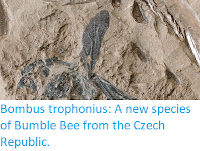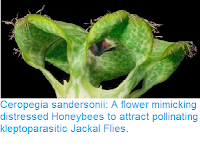Large Carpenter Bees, Xylocopa spp., are large Bees resembling Bumble Bees, Bombini, though they can generally be told apart by inspection of the abdomen, which tends to be glossier and less furry in Large Carpenter Bees. The name Carpenter Bee (which they share with Small Carpenter Bees, ceratina spp.) Comes from their habit of building nests in tough plant material, such as dead wood or Bamboo, though there are some ground nesting species. Most Large Carpenter Bees are solitary, though some species have a simple form of sociality, with females remaining in the nests of their mothers and sharing resources. Two different mating patterns are found within this group, with some species having large-headed, large-eyed males that actively hunt females to mate with, while others have small-headed males which release pheromones to attract females.
In a paper published in the journal ZooKeys on 23 November 2017, Michael Engel of the Division of Entomology at the Natural History Museum of the University of Kansas, the Department of Ecology & Evolutionary Biology, also at the University of Kansas, and the Division of Invertebrate Zoology at the American Museum of Natural History, Abdulaziz Alqarni of the Department of Plant Protection at King Saud University, Mohamed Shebl, also of the Department of Plant Protection at King Saud University, and the Department of Plant Protection at the Suez Canal University, Javaid Iqbal, again of the Department of Plant Protection at King Saud University, and of the Department of Entomology at the Muhammad Nawaz Shareef University of Agriculture, and Ismael Hinojosa-Díaz, of the Departamento de Zoología at the Universidad Nacional Autónoma de México, describe a new species of Large Carpenter Bee from the Sarawat Mountains of southwest Saudi Arabia.
The new species is named Xylocopa sarawatica, where 'sarawatica' in reference to the Sarawat Mountains, where it was discovered. Females of this species reach 14.8-17.0 mm in length, with the only male measured being 14.9 mm long. Both sexes are black or dark brown and covered in fur, which is again black over much of the body, though the fur on the upper part of the thorax is yellow.
Xylocopa sarawatica, female specimen. Engel et al. (2017).
See also...
Follow Sciency Thoughts on Facebook.







